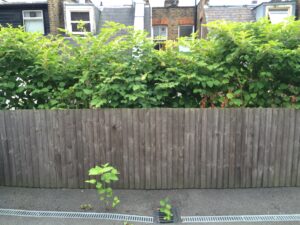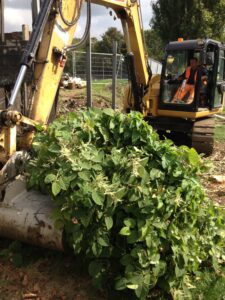What does it really cost to deal with Japanese knotweed?
Environet UK have written an article that discusses what is the real cost of dealing with the problem of Japanese knotweed.
With Japanese knotweed now affecting around 5% of properties in the UK, either directly or indirectly, it’s useful for homeowners and buyers to understand the costs associated with treating or removing it.
The answer isn’t straightforward but drawing on Environet’s historical quote data and my own 20+ years’ experience dealing with knotweed, I can provide an overview of indicative treatment and removals costs and some of the most common influencing factors.
The importance of a survey:
A professional Japanese knotweed survey will seek evidence of the plant above and below ground, determine the approximate size of the infestation, how long it’s been there, and the extent of rhizome spread. It will also determine the source of the infestation if it has encroached from a neighbouring property, whether any visible damage has been caused to buildings, drains, fences, patios and so on – and whether the plant is active or dormant.
A full survey report is provided along with a Japanese Knotweed Management Plan recommending the best course of action to deal with the problem. For clients who are buying a property affected by knotweed, they will need to show their lender evidence of a Management Plan being in place for a loan to be agreed.
Balancing costs and long-term goals:
Herbicide treatment is usually the most affordable method of tackling knotweed, but it’s considered only to be a form of control, rather than removal, as it often induces the plant into dormancy. That means it’s technically still alive and if the ground is disturbed it could be prompted to regrow – even many years after treatment.
Homeowners opting for herbicide cannot therefore declare their property ‘knotweed-free’, which can impact its appeal to future buyers and its market value. But for those who are planning to keep the property long-term, or who want to control the problem at minimum cost, it’s a great option. Herbicide can only be applied when the plant is in leaf, however, meaning it’s not suitable for the winter months when knotweed dies back.
A more ‘belt and braces’ approach is to excavate the plant from the ground, removing all the underground rhizome to ensure it’s gone for good. Environet’s Resi-Dig-OutTM method does just this, digging the plant out of the ground, sifting the knotweed rhizome from the soil and then returning the clean soil to the ground. This is an excellent option for sellers of residential property, as with a ten-year insurance-backed guarantee (IBG), they can provide greater assurances to buyers that the property is knotweed-free.
A combination method, DARTTM is also popular during winter, when options are more limited. It involves removing the bulk of the knotweed crowns and rhizomes to significantly reduce the plant’s vigour, before treating any weak regrowth with herbicide during the summer months. This is a very cost-effective solution and avoids major disruption in the garden during summer when it’s most in use.
Size of the infestation:
The size of the area infested with Japanese knotweed is the next factor that will determine treatment costs. The greater the area, the higher the cost – and the affected area could be much larger than it first appears, since the plant’s rhizomes may have spread further beneath the ground.
The longer it is left untreated, the greater the costs are likely to be, as it will spread further and there’s greater risk of encroachment into a neighbouring property or damage to structures such as sheds, paths, walls and patios – as well as homes.
Site access and conditions:
If there’s limited access, for example in certain terraced properties, it may be necessary to install temporary surfaces, lift machinery over walls or even excavate the knotweed by hand.
Site conditions also play a role, such as the depth and maturity of the knotweed, the extent of its lateral spread and whether drains and services are impacted.
Guarantee requirements:
A robust guarantee is essential when selling a property affected by Japanese knotweed. Most lenders will insist on them and when it comes to securing a loan, the quality of the guarantee matters. It should always be insurance-backed, so if the knotweed removal company goes out of business, the customer is still protected.
Most guarantees are 5 years as standard but should ideally be for a 10-year period, as knotweed regrowth has been known to emerge many years after apparently successful treatment.
Indicative costs:
Once the most suitable treatment method has been determined, taking into account budget and objectives, and the size of the infestation, site conditions and guarantee requirements have been considered, the cost can be calculated.
Tackling a 5m2 stand of knotweed, with a 5-year insurance-backed guarantee, is likely to cost £3,500 including VAT for herbicide control, £6,500 for complete removal (Resi-Dig-OutTM) or £4,500 for the combination DARTTM method.
In most circumstances, sellers will be required to put the treatment plan in place and pay for the works, although there may still be some diminution of the property’s value arising from the so-called ‘knotweed stigma’. Removal of knotweed is the most effective way to preserve a property’s value, which is why around 70% of our customers now opt for excavation over herbicide, providing peace of mind to themselves and to potential buyers, despite the higher cost.
By Nic Seal, founder of invasive plant specialists Environet.
Kindly shared by Environet UK

















